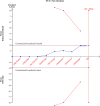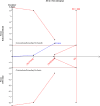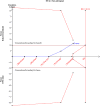Effects of chloride content of intravenous crystalloid solutions in critically ill adult patients: a meta-analysis with trial sequential analysis of randomized trials
- PMID: 30758680
- PMCID: PMC6374495
- DOI: 10.1186/s13613-019-0506-y
Effects of chloride content of intravenous crystalloid solutions in critically ill adult patients: a meta-analysis with trial sequential analysis of randomized trials
Abstract
Background: Intravenous crystalloid solutions are administered commonly for critically ill patients. We performed this meta-analysis of randomized trials with trial sequential analysis (TSA) to evaluate effects of chloride content of intravenous crystalloid solutions on clinical outcomes among critically ill adult patients.
Methods: Electronic databases were searched up to June 1, 2018, for randomized trials of use of balanced crystalloids versus 0.9% saline solutions in critically ill adult patients. The outcome variables included mortality, renal outcomes, serum content alterations and organ function. Subgroup analysis was conducted according to patient settings, types or volume of crystalloid fluid, or among sepsis versus non-sepsis, TBI versus non-TBI or subpopulations by the categories of baseline kidney function. Random errors were evaluated by trial sequential analysis.
Results: Eight studies with 19,301 patients were analyzed. A trend of in-hospital survival benefit with no statistical difference could be observed with balanced crystalloids compared with 0.9% saline (RR 0.92, 95% CI 0.85-1.0, p = 0.06). The use of balanced crystalloid solutions was associated with longer RRT-free days (SMD 0.09, 95% CI 0.06-0.12, p < 0.001), less risk of increase in serum concentrations of chloride (SMD - 1.23, 95% CI - 1.59 to - 0.87, p < 0.001) and sodium (SMD - 1.28, 95% CI - 1.65 to - 0.92, p < 0.001), less risk of decline in serum base deficit (SMD - 0.58, 95% CI - 0.98 to - 0.18, p = 0.004), longer ventilator-free days (SMD 0.08, 95% CI 0.05-0.11, p < 0.001) and vasopressor-free days (SMD 0.04, 95% CI 0.00-0.07, p = 0.02). Subgroup analysis showed that balanced crystalloid solutions were associated with a reduced in-hospital mortality rate among septic patients (RR 0.86, 95% CI 0.75-0.98; p = 0.02) and non-traumatic brain injury patients (RR 0.90, 95% CI 0.82-0.99, p = 0.02), while the TSA results indicated a larger sample size is still in need.
Conclusions: Limited evidence supported statistical survival benefit with balanced crystalloid solutions, while it benefited in reducing organ support duration and fluctuations in serum electrolyte and base excess and was associated with decreased in-hospital mortality in subpopulation with sepsis and non-TBI. Large-scale rigorous randomized trials with better designs are needed to provide robust evidence for clinical management. Trial registration The protocol for this meta-analysis was registered on PROSPERO: International prospective register of systematic reviews (CRD42018102661), https://www.crd.york.ac.uk/prospero/#recordDetails.
Keywords: 0.9% Saline; Critically ill patients; In-hospital mortality; Lactated Ringers; Plasma-Lyte 148; Renal outcome.
Figures







Similar articles
-
Balanced crystalloids versus normal saline for fluid resuscitation in critically ill patients: A systematic review and meta-analysis with trial sequential analysis.Am J Emerg Med. 2019 Nov;37(11):2072-2078. doi: 10.1016/j.ajem.2019.02.045. Epub 2019 Mar 1. Am J Emerg Med. 2019. PMID: 30852043
-
Balanced Crystalloids Versus Saline in Critically Ill Adults: A Systematic Review and Meta-analysis.Ann Pharmacother. 2020 Jan;54(1):5-13. doi: 10.1177/1060028019866420. Epub 2019 Jul 31. Ann Pharmacother. 2020. PMID: 31364382
-
Fluid resuscitation with balanced crystalloids versus normal saline in critically ill patients: a systematic review and meta-analysis.Scand J Trauma Resusc Emerg Med. 2022 Apr 18;30(1):28. doi: 10.1186/s13049-022-01015-3. Scand J Trauma Resusc Emerg Med. 2022. PMID: 35436929 Free PMC article.
-
Comparison of Balanced Crystalloids versus Normal Saline in Critically Ill Patients: A Systematic Review with Meta-Analysis and Trial Sequential Analysis of Randomized Controlled Trials.Ther Clin Risk Manag. 2023 Oct 11;19:783-799. doi: 10.2147/TCRM.S416785. eCollection 2023. Ther Clin Risk Manag. 2023. PMID: 37850070 Free PMC article.
-
Balanced crystalloids versus saline in the intensive care unit: study protocol for a cluster-randomized, multiple-crossover trial.Trials. 2017 Mar 16;18(1):129. doi: 10.1186/s13063-017-1871-1. Trials. 2017. PMID: 28302179 Free PMC article. Clinical Trial.
Cited by
-
The surviving sepsis campaign: fluid resuscitation and vasopressor therapy research priorities in adult patients.Intensive Care Med Exp. 2021 Mar 1;9(1):10. doi: 10.1186/s40635-021-00369-9. Intensive Care Med Exp. 2021. PMID: 33644843 Free PMC article. Review.
-
New Insights into the Fluid Management in Patients with Septic Shock.Medicina (Kaunas). 2023 May 29;59(6):1047. doi: 10.3390/medicina59061047. Medicina (Kaunas). 2023. PMID: 37374251 Free PMC article. Review.
-
Critical Care Management of Patients After Cardiac Arrest: A Scientific Statement from the American Heart Association and Neurocritical Care Society.Neurocrit Care. 2024 Feb;40(1):1-37. doi: 10.1007/s12028-023-01871-6. Epub 2023 Dec 1. Neurocrit Care. 2024. PMID: 38040992 Free PMC article.
-
The Impact of Intravenous Fluid Therapy on Acid-Base Status of Critically Ill Adults: A Stewart Approach-Based Perspective.Int J Nephrol Renovasc Dis. 2020 Sep 30;13:219-230. doi: 10.2147/IJNRD.S266864. eCollection 2020. Int J Nephrol Renovasc Dis. 2020. PMID: 33061531 Free PMC article. Review.
-
Enteral Lactoferrin Supplementation for Preventing Sepsis and Necrotizing Enterocolitis in Preterm Infants: A Meta‑Analysis With Trial Sequential Analysis of Randomized Controlled Trials.Front Pharmacol. 2020 Aug 7;11:1186. doi: 10.3389/fphar.2020.01186. eCollection 2020. Front Pharmacol. 2020. PMID: 32848789 Free PMC article. Review.
References
Grants and funding
LinkOut - more resources
Full Text Sources
Research Materials

